Serving 846 students in grades 9-12, Kearsley High School ranks in the top 50% of all schools in Michigan for overall test scores (math proficiency is bottom 50%, and reading proficiency is bottom 50%).
The percentage of students achieving proficiency in math is 20-24% (which is lower than the Michigan state average of 34%). The percentage of students achieving proficiency in reading/language arts is 50-54% (which is higher than the Michigan state average of 45%).
The student:teacher ratio of 19:1 is higher than the Michigan state level of 17:1.
Minority enrollment is 30% of the student body (majority Black), which is lower than the Michigan state average of 37% (majority Black).
Quick Stats (2025)
- Grades: 9-12
- Enrollment: 846 students
- Student:Teacher Ratio: 19:1
- Minority Enrollment: 30%
- Graduation Rate: 80-84% (Top 50% in MI)
- Overall Testing Rank: Top 50%
- Math Proficiency: 20-24% (Btm 50%)
- Reading Proficiency: 50-54% (Top 50%)
- Science Proficiency: 35-39% (Top 50%)
- Source: National Center for Education Statistics (NCES), MI Dept. of Education
School Overview
Kearsley High School's student population of 846 students has declined by 13% over five school years.
The teacher population of 45 teachers has declined by 8% over five school years.
Grades Offered
Grades 9-12
Total Students
846 students
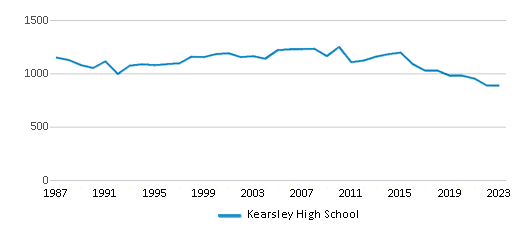
Gender %

Total Classroom Teachers
45 teachers
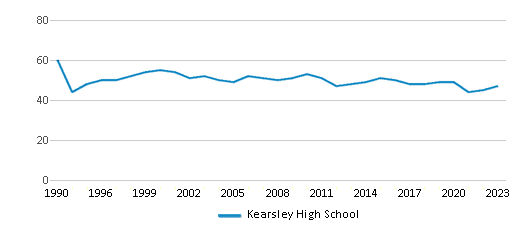
Students by Grade
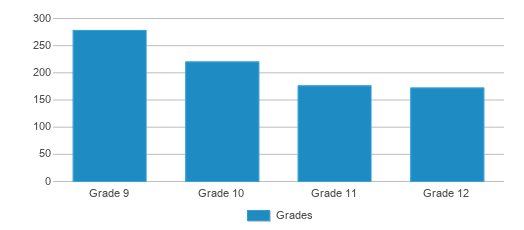
School Rankings
Kearsley High School ranks within the top 50% of all 3,069 schools in Michigan (based off of combined math and reading proficiency testing data).
The diversity score of Kearsley High School is 0.48, which is less than the diversity score at state average of 0.56. The school's diversity has stayed relatively flat over five school years.
Overall Testing Rank
#1493 out of 3069 schools
(Top 50%)
(Top 50%)
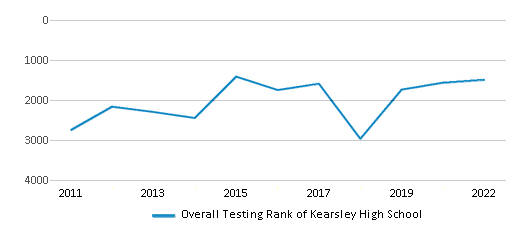
Math Test Scores (% Proficient)
20-24%
34%
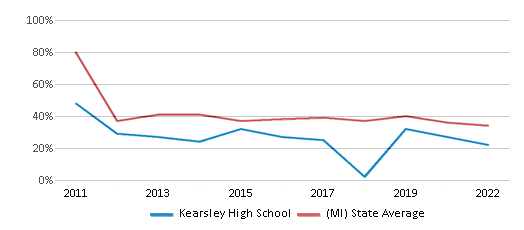
Reading/Language Arts Test Scores (% Proficient)
50-54%
45%
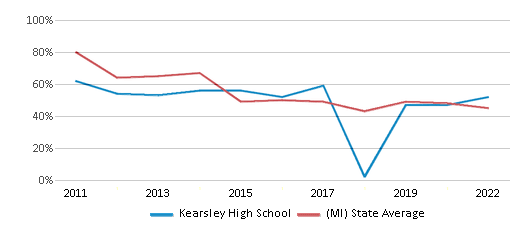
Science Test Scores (% Proficient)
35-39%
38%
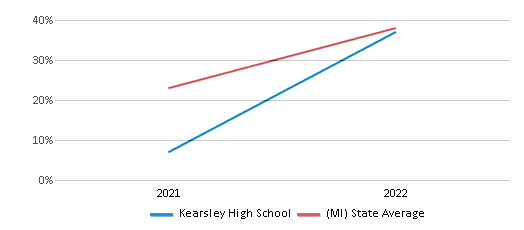
Student : Teacher Ratio
19:1
17:1
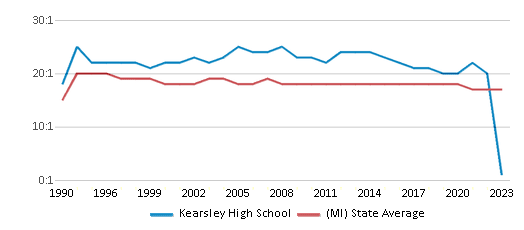
American Indian
n/a
1%

Asian
n/a
4%
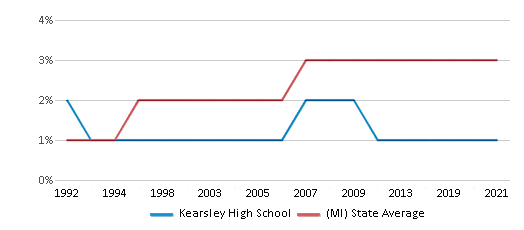
Hispanic
10%
9%
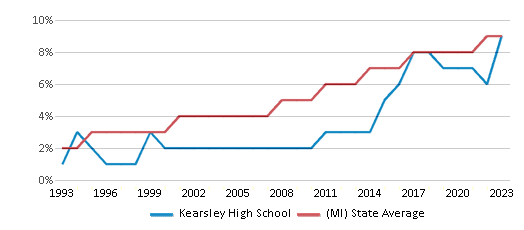
Black
13%
18%
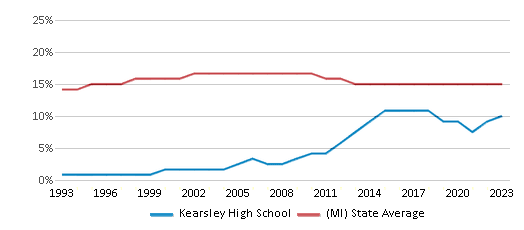
White
70%
63%

Hawaiian
n/a
n/a
Two or more races
7%
5%
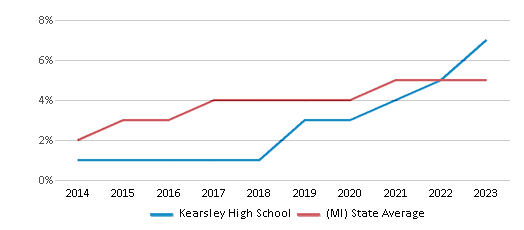
All Ethnic Groups
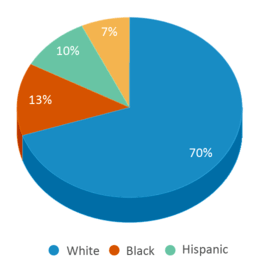
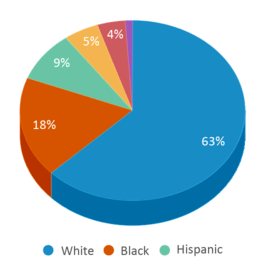

Graduation Rate
80-84%
81%
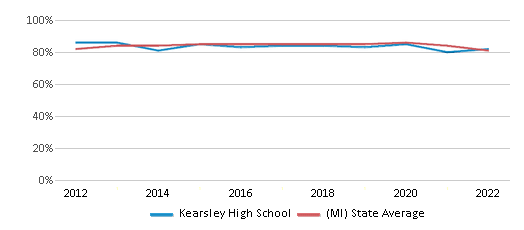
Participates in the National School Lunch Program (NSLP)
Yes
Eligible for Free Lunch
70%
50%

Eligible for Reduced Lunch
4%
4%
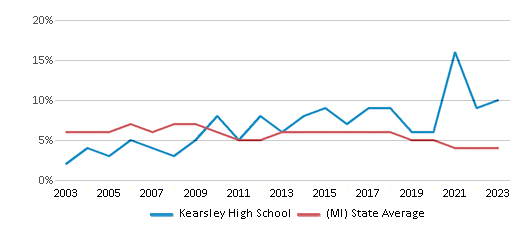
School Statewide Testing
School District Name
Source: National Center for Education Statistics (NCES), MI Dept. of Education
Profile last updated: 02/09/2025
Frequently Asked Questions
What is Kearsley High School's ranking?
Kearsley High School is ranked #1493 out of 3,069 schools, which ranks it among the top 50% of public schools in Michigan.
What schools are Kearsley High School often compared to?
Kearsley High Schoolis often viewed alongside schools like Davison High School by visitors of our site.
What percent of students have achieved state testing proficiency in math and reading?
20-24% of students have achieved math proficiency (compared to the 34% MI state average), while 50-54% of students have achieved reading proficiency (compared to the 45% MI state average).
What is the graduation rate of Kearsley High School?
The graduation rate of Kearsley High School is 80-84%, which is lower than the Michigan state average of 81%.
How many students attend Kearsley High School?
846 students attend Kearsley High School.
What is the racial composition of the student body?
70% of Kearsley High School students are White, 13% of students are Black, 10% of students are Hispanic, and 7% of students are Two or more races.
What is the student:teacher ratio of Kearsley High School?
Kearsley High School has a student ration of 19:1, which is higher than the Michigan state average of 17:1.
What grades does Kearsley High School offer ?
Kearsley High School offers enrollment in grades 9-12
What school district is Kearsley High School part of?
Kearsley High School is part of Kearsley Community School District.
School Reviews
3 12/6/2018
I believe the educational system in this country is just appalling! Kearsley High School is no exception. The quality of education there has gone down hill over the past 10 years. Kearsley High School use to rank in the top 50% of Michigan schools. Now they rank in the bottom. A very small percentage of the kids that graduate there are prepared for college. If Johnny can't read, don't pass him until he can. Otherwise, Johnny goes to college and flunks out of his English course and is unable to write papers in his non-English courses. College teachers should not be required to teach students basic math and English courses. That is the job of the grade school, middle school and high school teachers.On a side note to parents of either current or non-current Kearsley High School students commenting on this and other sites, "please" use spell check. I see some parents giving Kearsley High School four and five stars. However, I cannot help but cringe when I read some of these reviews. Comments like, "I think that its a good place to learn and have a "grate" education", just make me sad.
5 5/12/2014
I think that kearsley schools are good schools as far as learning and I think that they need to make more improvements to the elementary schools that need it. I am a kearsley parent with two kids and I think that its a good place to learn and have a grate education.
Review Kearsley High School. Reviews should be a few sentences in length. Please include any comments on:
- Quality of academic programs, teachers, and facilities
- Availability of music, art, sports and other extracurricular activities
Recent Articles

What Is A Charter School?
Explore the world of charter schools in this comprehensive guide. Learn about their history, how they operate, and the pros and cons of this educational innovation. Discover key facts about charter schools, including admission policies, demographics, and funding, as well as what to look for when considering a charter school for your child.

10 Reasons Why High School Sports Benefit Students
Discover the 10 compelling reasons why high school sports are beneficial for students. This comprehensive article explores how athletics enhance academic performance, foster personal growth, and develop crucial life skills. From improved fitness and time management to leadership development and community representation, learn why participating in high school sports can be a game-changer for students' overall success and well-being.

February 05, 2025
Understanding the U.S. Department of Education: Structure, Impact, and EvolutionWe explore how the Department of Education shapes American education, from its cabinet-level leadership to its impact on millions of students, written for general audiences seeking clarity on this vital institution.









